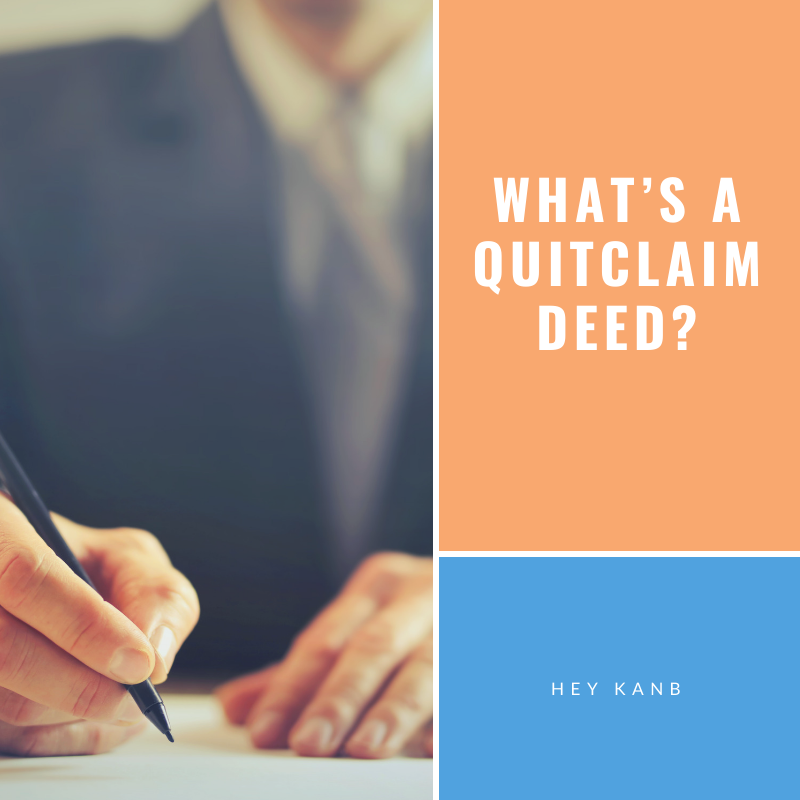What is a Quitclaim Deed?
What is a deed?
Deeds are used to legally transfer ownership of real property. This is also known as “conveyance of interest”. By signing and recording this deed, the previous owner cannot later claim to still have ownership of said property. While there are several different versions of this legal document, today I want to introduce you to the quit claim deed.
What is a Quitclaim deed?
Often, when you purchase your home you are issued a general warranty deed. This offers you, the buyer or grantee, protection against other interest claims to the real property you just purchased. In the case of the quitclaim deed, there is generally less protection.
With a quit claim deed, the grantor will sign the deed to release his or her interest in the real property. This deed does not guarantee the quality of the title of the real property in question, it only means the previous owner, or grantor, relinquishes legal right to claim ownership or interest in the property.
Important reminder: Quitclaim deeds affect ownership of a home, but it does not transfer mortgage responsibility. If there is a mortgage on the home and the mortgage holder signs a quitclaim deed to someone, that person is still responsible for the mortgage even though they no longer own the home. The quitclaim deed also does not provide the buyer protection from further defects on the title.
When are Quitclaim deeds used?
Usually, these are used when property ownership is transferred without a traditional sale. Quitclaim deeds are often used in divorces, when one spouse signs a quit claim deed over to the other spouse as the outcome of the divorce settlement.
They are also commonly used to transfer property from one family member to another. Let us say Timmy and his brother Jimmy inherited their family home when their parents died. If Timmy wanted to live in the home, and his brother Jimmy did not want the home, Jimmy could sign a quitclaim deed so that his name, and his ownership interest in the home, would be removed.
Another common use of the quitclaim deed is when real property is transferred via a tax sale. When a property is sold at a tax sale and the new owner takes possession, they can face delays when they go to sell that property if the previous owner, who lost the property due to delinquent taxes, has not signed a quit claim deed.
Example: Trent neglected to pay his property taxes. After being notified of the delinquency, the county sold his property at a tax sale (yes, he had time to pay his overdue balance prior to the sale). Samantha bought this property at the tax sale. She decides to sell it later that year. Unfortunately, the sale fell through because the title check found a cloud on the title and the buyer got cold feet and backed out. If Trent had signed the quitclaim deed, Samantha could have sold the property without the unnecessary delay. Since the quitclaim deed was not used, when the title company did the title check it looked like Trent still had ownership of the property and Samantha could not legally sell it. When Samantha bought the property at the tax sale, she could have legally asked Trent to sign the quitclaim deed to remove the cloud from the title.
How do I use a Quitclaim deed?
You can download a template from places like LegalZoom, or you can visit your friendly neighborhood attorney and get their help. Remember that you need certain items in order to make the document legal. It will need a legal description of the property, the county it’s located in, the date the property is being deeded over, the full names of the grantor (previous owner) and the grantee (new owner), signatures from both both parties, and (depending on the state) signatures of witnesses. If money is paid, that amount should also be included (Be sure to ask an attorney for help if you have legal questions). Also be sure to record the deed with the county clerk. This is so important in the process as it removes clouds from the title of the property.
To sum it up, quitclaim deeds can be an effective way to transfer ownership of real property and are usually used when there is no money transferred from the new owner to the previous owner. They can be used to clear defects on titles, such as misspelled names, or tax liens. When looking to acquire a property via a quitclaim deed, you should proceed with caution. Quit claim deeds do not protect you from other liens on a property that the owner has not disclaimed to you.
Disclaimer: As a parting shot, let me add this disclaimer: I am not a legal professional, nor am I qualified to practice law in any way. This blog is written based on research, personal experience, and professional real estate education. When in doubt about legal matters, you should seek out an attorney.
Do you have more questions? Drop a comment below or shoot me an email in the contact us section.
As always, I am but a work in progress.
Cheers.
KANB





